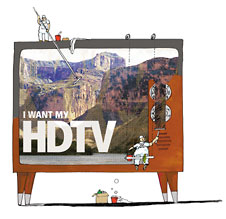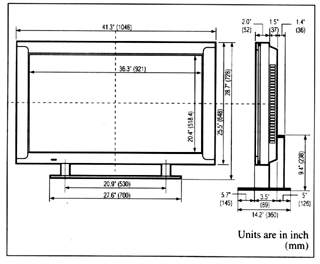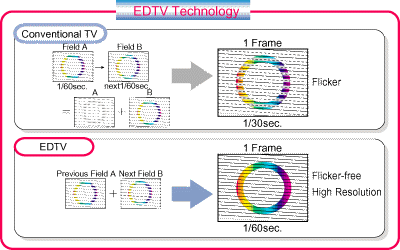
| Video Technology Magazine | February 2004 |

"We as an industry have managed to confound the consumer even in the most basic consumer electronic device -- their TV," Kleisterlee said. "Our future is in the balance. Complexity is intrinsic in technology but simplicity is how we should bring it to the consumer."
Attack of Alphabet Soup.With companies like Daewoo, Panasonic, Philips, Samsung, and Zenith offering "EDTV" televisions.From what I can tell EDTV only offers improved resolutions at 480i and maybe does some de-interlacing to get 480p, Zenith lists 852x480p output on there 42" set. While I see "HD-Ready" TV's that offer 1,024 x 768 like Panasonics TH-PX20U 42". But this is NOT HDTV!!!!! 1024x768 is a great resolution for a computer graphics card but this doesn't correspond to any HDTV resolutions. In an article below I go into more detail about EDTV. I have started seeing some companies like Hitachi start to call there sets VirtualHD and this also seems to be very similar to EDTV. Manufacturers list features such as wide-screen 16:9 format TV's, SDTV, DTV, IDTV, DVI, HDCP, HD3D, DCDi, Vortex, "Digital Crystal Clear", iTV, and "HD Components". I spend much of my time keeping up on HDTV and video and I can't keep up with the speed that new buzz words are being created by clueless marketing executives.
It's not at all surprising to think the average consumers are getting confused by all this.
Articles to work on are
Intel 1920x1080 LCOS and here , SACD, DVD-A, DVI-D/HDCP, WMVHD,
According to Philips "Enhanced Definition Television" According to the US Government - ITS Institute for Telecommunications Sciences
|
|
This article still under construction
|
Cool Links for this month
The Stereoscopic Cinema: From Film to Digital ProjectionBy Lenny Lipton
Augmented Reality Image collection A funny collection of AR and VR gear
SasemKorean Company that makes an HDTV Card an Editors
HDTV Magazine at ILoveHDTV.com looks interesting.
HighDef.com Another Magazine
USDC United States Display Consortium
DisplaySearch.com Self Proclaimed leader in FPD(Flat Pannel Display) Market Research and Consulting
Stuff about display technology:
Display Technologies Guide
Excellent article from AudioHolics web site.
The Differences between LCD, Plasma, DLP, LCOS, D-ILA, and CRT Televisions and Displays
SlashDot also linked to this and has a very lively discussion on the subject
Intel (LCOS) and Texas Instruments (HD2+) are also discussed on the SlashDot post. Something I hope to write an article about soon.
Another mentioned in SlashDot - Cannon SEDs
and EETimes article on SED
surface-conduction electron-emitter display (SED).
Scientific American - February 2004: Print Issue has a good article on Flexible Displays on Page 76. The best part of the article is the discussion on Organic LED's
HDTV Television - An Introduction University of Washington Lecture Notes
DataCompression.Info has lots of great stuff about compression and video
Mike Shaw's Pinnacle's Studio Pages
I am interested in PC/Windows based video editing packages, please send advice or any info on video editors - The Editor, My E-mail address is above
Slashcam Links to video codecs
German - eDigiCam Digital Camera Shop
|
Nisvara - Silent computers and Heat Management
|
Red Herring Inc. - IC Report - December 2003 - Vol.2, No. 1
NISVARA
Chip-Cooling Systems
Moffett Field, California
http://www.nisvara.com
The more powerful the microprocessor, the more heat it generates. And that is a problem. Heat bakes components and corrupts them over time. Worse, the fans that cool chips are not only loud, they fail often. Thus the search for a quieter, more reliable cooling technology.
Nisvara, a startup backed by the Girvan Institute – a NASA fund set up to transfer technology into and out of the space agency – is using materials developed at NASA to beat the heat.
Nisvara CTO and founder John Sokol’s solution is a material made of carbon nanotubes. It can withstand great heat and is one-sixth the weight and 100 times stronger then steel. Nisvara makes both active and passive cooling systems. The active system involves a liquid coolant; the passive system uses a heat sink (essentially a piece of metal with many blades) to soak up heat and vent is away.
One area of particular appeal for Nisvara’s technology is the server market, where it could substantially reduce the cost of operating a data center or server farm. Fan failure is the number-one cause of server failure. What’s more, over half of the electricity used by data centers and server farms is for air conditioning. No fans also means less vibration-caused tracking errors, which are a problem in the SAN/NAS hardware arena.
But Nisvara’s immediate plans are in the PC market. The company hopes to make early revenue by selling a high-end silent PC aimed at programmers and other who value noise reduction. Another potential near-term market is in media production, where silence is highly valued.
Nisvara has filed for a provisional patent on it’s technology, which is says is differentiated by its approach to cool the entire machine rather then the chip alone. It is now seeking the first $1 million of a $5 million series A round.
Rob Chaplinsky, a general partner at Mohr, Davidow Ventures who has been monitoring new cooling technologies for the past two years, calls chip cooling ”an unexplored industry that’s in need of disruptive technology.” Chaplinsky is an investor in Cooligy, perhaps the best-known startup in the field. Other competitors include Active Cool, Cool Chips and Isothermal Systems Research. While Chaplinsky thinks there is still room for competition – he sizes the cooling market at $1 billion on the PC side alone – he points out that startups like Nisvara that are still in the research phase won’t have a working product for several years, while Cooligy is already testing a prototype with customers.
Cooligy Inc | Active Cool | Cool Chips | Isothermal Systems Research - SprayCool™
|
Brazil Takes Lead in All-Digital Cinema Projection
|
"Andrew Downie reports that Brazil plans to open in May the world's largest digital movie theater network. About 100 theaters will use Sao Paulo-based Rain Networks' KinoCast digital theater DRM software. Rain based its system on Windows Media 9 software with MPEG-4 video compression. ' The MPEG-4 software can squeeze a feature film onto a file of just five gigabytes, 15 times smaller than the MPEG-2 technology presently used' at one-third the $150,000 cost. It takes 20 minutes to distribute a 90-minute film over a VPN and the system avoids the costs associated with transporting physical copies to areas largely inaccessible by road - it can cost up to $750,000 for 500 copies of a Matrix-type blockbuster to be distributed. Interestingly, in the affluent USA the fight between the 35,000 theater owners and Hollywood is about who will pay for cinemas to switch to digital projection. In December 2003 the Guardian published a story with more financial and technical details of the KinoCast digital cinema system."
|
Pioneer Acquires NEC's Plasma Division
|

After the acquisition, Pioneer’s market share of plasma display manufacturing is expected to rise from 14 percent today, as estimated by analysts, to what Pioneer predicts to be 22 percent.
Pioneer's annual PDP (Plasma Display Products) production capacity will increase to 1.1 million units after the company acquires the NEC subsidiary and a new production line under construction in Yamanashi Prefecture begins operating.
The combined global market share of Japanese PDP manufacturers-Fujitsu Hitachi Plasma Display, Matsushita Electric Industrial Co., Pioneer and NEC-is expected to have dropped under 70 percent in 2003 from about 80 percent the previous year, according to U.S. market researcher DisplaySearch.
In the global market for flat-panel products, South Korean rivals such as Samsung Electronics Co. and LG Electronics Inc. are gaining quickly on Japanese makers.
Pioneer forecasts that the global market for PDPs will triple in two years to more than 3 million units at the end of fiscal 2004
Kaneo Ito, Pioneer president, said the PDP market is expected to nearly double in size each year over the next few years, leaping from 590,000 units last year to 3.5 million in 2006.
|
Hasbro VideoNow PVD - Personal Video Disk Player
|
This is not to be confused with the old VideoNow product by ViVo/VivoActive. That company was bought up by Real Video and killed. I guess there's no trademark issues for some reason.

Specs
- Video is 80x80, with (4 bit)16 shades of grey, at 15 fps

- Data is stored as audio tracks on the PVDs
- PVDs are 85mm in diameter small standard CD's.
- Video is stored as Uncompressed data packets on the left audio track.
- Audio is stored on the right side, as 8 bit stereo. Upon separating the 16 bit mono to 8 bit stereo, we found the left side to be timing marks (though they don't match up with the frames), and the right side to be clear audio
- Converted Audio CD player
Where it gets interesting
There are now opensource applications in C and Java to create your own VideoNow DisksClick here for additional information and links on this

This is the official Hasbro site
Buy it here:
VideoNow Color Personal Video Player
|
Amiga Video Toaster software source code released
|


The NewTek Video Toaster for the Amiga was released over 10 years ago. It has just recently been released open source by NewTek.

The Amiga Video Toaster launched an entire industry with Hobbist pricing and professional feature set. Replacing $250,000 of broadcast quality TV studio equipment the Amiga Video Toaster allowed anyone that could afford an Amiga to get into video production.
The same team that developed the Toaster eventual went on to form Play Inc. that producted the Snappy frame grabber and the Trinity/Globecaster that is now being made by GlobalStreams, Inc. The Trinity/Globecaster is a super high end professional version of the Original Video Toaster.
GlobalStreams, and VirtualSetWorks have an amazing set of special effect including Virtual Set that Pan, Tilt and Zoom with the camera, the Virtual field markers that are used in the super-bowl and, perhaps could have prevented 143 Million Viewers from seeing more then they expected to of Janet Jackson.
The Video Toaster source code is available at OpenVideoToaster.Org
|
Build your own PVR from scratch
|
PVR's can run or Windows or Linux below is a list of packages for this:
FreeVo
GB-PVR
Guide Parser Parses web Based TV Guide data into XML
MythTV Linux home-brew PVR
Linux KnoppMyth a more usable version of MythTV
XMLTV XML TV Guide Data Base and Utilities
OpenPVR also on SourceForge
LinPVR Linux mini version of MythTV
Sage TV Commercial Product for Windows $59.96 ,Free Trial Period.
WinTV-PVR-350 Hauppauge sells a card and software for $199 US
Show Shifter Commercial Windows PVR $39 to $114 US there are several level of product
Dave/Dina Project and at SourceForge connects to your TV screen, stereo, phone, and other stuff, running open-source software
Video Disk Recorder Linux Recorder for DVB-S Digital Satellite Receiver from Fujitsu/Siemens
Snap Stream Commercial Windows PVR - Beyond TV $59.99 US
WebVCR
Build Your Own PVR!
|
|

